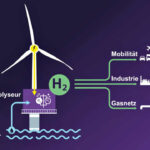Hydrogen: Recognising potential, exploiting opportunities
A clean, secure and affordable energy supply is essential for our lives. The energy transition lays the foundation for this with our efforts and successes in the expansion of renewable energies and in the area of energy efficiency. With the decisions of the Federal Cabinet on the Climate Protection Programme 2030, the Federal Government has created the prerequisites for achieving the 2030 climate targets. In doing so, it is pursuing the long-term goal of climate neutrality in line with the goals of the Paris Agreement to keep global warming well below 2 degrees and, if possible, to limit it to 1.5 degrees. Germany, together with the states of the European Union, has also committed to the goal of greenhouse gas neutrality in 2050. Following the decisions to phase out coal, this means that emissions that are very difficult to reduce, such as process-related greenhouse gases from industry, must also be avoided as far as possible.
A successful energy transition means combining security of supply, affordability and environmental compatibility with innovative and intelligent climate protection. For this, we need alternative options to the fossil energy sources currently still in use. This applies in particular to gaseous and liquid energy sources, which will remain an integral part of the energy system in the long term in an industrialised country like Germany. Hydrogen 1 will play a central role in the further development and completion of the energy transition:
Hydrogen is a versatile energy carrier. For example, it can be used in fuel cells to promote hydrogen-based mobility and in the future as a basis for synthetic fuels.
Hydrogen is an energy storage medium that can flexibly store renewable energies in a supply-oriented manner and contribute to balancing supply and demand. This makes hydrogen an important building block of the energy transition.
Hydrogen is an essential element of sector coupling. In areas where electricity from renewable energies cannot be used directly, green hydrogen and its downstream products (power-to-X) open up new decarbonisation paths.
Hydrogen is already indispensable in various chemical and industrial processes. For example, it is needed as a basic material for the production of ammonia. In the future, the fossil-generated hydrogen already used today is to be replaced. Furthermore, by using hydrogen as a basic material, it can decarbonise further production processes in industry for which no other decarbonisation technologies are available according to the current state of the art. For the greenhouse gas-neutral production of primary steel, for example, the use of hydrogen as a substitute for hard coal coke is currently the most promising technological path.
Certain industrial CO2 sources, for example process-related emissions from the cement industry, can only be decarbonised in the long term with the help of hydrogen. Thus, captured industrial CO2 emissions can be converted into usable chemicals with hydrogen (CCU) and new value chains can be opened up for the basic materials industry.



